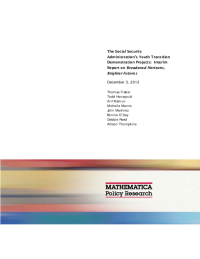Interim Report on Broadened Horizons, Brighter Futures
The Youth Transition Demonstration (YTD) is a large-scale demonstration and evaluation sponsored by the Social Security Administration (SSA) to improve understanding of how to help youth with disabilities reach their full economic potential. In particular, SSA is interested in testing promising approaches for helping young people with disabilities become more self-sufficient and less reliant on disability benefits. SSA has contracted with Mathematica Policy Research (MPR), Inc., to develop and evaluate the YTD projects. MPR has assembled a team for the evaluation that includes MDRC, disability program experts from TransCen, Inc., and academic specialists.
The YTD conceptual framework, which was based on best practices in facilitating youth transition, specified that the six projects that participated in the evaluation provide employment services (emphasizing paid competitive employment), benefits counseling, links to services available in the community, and other assistance to youth with disabilities and their families. Additionally, the youth who received those services were eligible for SSA waivers of certain benefit program rules, which allowed them to retain more of their disability benefits and health insurance while they worked for pay. Using a rigorous random assignment methodology, the YTD evaluation team is assessing whether these services and incentives were effective in helping youth with disabilities achieve greater independence and economic self-sufficiency. The earliest of the evaluation projects began operations in 2006 and ended in 2009. The latest started in 2008 and ended in 2012.
In this report, we present first-year evaluation findings for Broadened Horizons, Brighter Futures (BHBF), which served youth ages 16 through 22 in Miami-Dade County, Florida, who were Social Security disability beneficiaries. While it will take several more years before we fully observe the transitions that the participants in this study make to adult life, early data from the evaluation provide rich information on how BHBF operated and the differences it made in key outcomes for youth. Specifically, the report includes findings from our process analysis of BHBF, including a description of the program model, and documentation of how the project was implemented and services were delivered. The report also includes impact findings, based on data collected 12 months after youth entered the evaluation, on the use of services, paid employment, educational progress, income from earnings and benefits, and attitudes and expectations.
In brief, we learned that BHBF was well implemented and had statistically significant impacts on several important outcomes during the year following random assignment. Through the process analysis, we learned that BHBF enrolled 84 percent of eligible youth as participants in the project and provided all of the participants with at least some services. We also found that those services conformed to the YTD program model and focused on person-centered planning, employment, financial literacy, benefits planning, and case management to resolve barriers to employment. On average, enrollees received 29 hours of services, just under half of which were employment related, such as the development of work experiences, job placement, and job coaching. The impact analysis found that youth who had been given the opportunity to participate in BHBF were more likely to have used services to promote employment and to have been employed for pay than in the absence of the intervention. BHBF also had a positive impact on youth income from earnings and benefits, combined. However, the project had no impacts on youth expectations for the future or a composite measure of school enrollment or high school completion.






